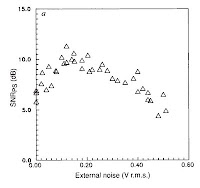 In one of those end-of-the-year "Top 10" lists that are so popular, New Scientist compiled a list of its top 10 brain articles. As I scanned through the list, I spotted one that I knew had a crayfish connection: "Does the brain feature built-in noise?"
In one of those end-of-the-year "Top 10" lists that are so popular, New Scientist compiled a list of its top 10 brain articles. As I scanned through the list, I spotted one that I knew had a crayfish connection: "Does the brain feature built-in noise?"When you type "crayfish" into Google Scholar, the first two hits, with over 600 citations each, both relate to noise, and they concern one experiment. The first contains a review of the second, so the second paper, by Douglass and collegues (1993), is the primary article.
The paper is about stochastic resonance in crayfish.
Yup. That one's going to take some explaining.
Imagine you're on the ground, trying to pick apples off an apple tree on a completely calm, windless day. You can only reach (or jump!) so far, and the apples on the branch remain just out of reach.
Now imagine the same scenario, but instead with a little gust wind blowing. Now the branches, instead of staying still, start to sway in the breeze. And just once in a while, that extra push from the breeze puts an apple close enough that you can grab it. That random movement of gusty wind actually helped accomplish something. That's much like stochastic resonance.
Of course, there will be limits to this. If the wind gets too severe, the branches of the apple tree will be flailing around so much that grabbing an apple will get harder and harder, not easier.
The New Scientist article put it like this:
Noise is usually a nuisance, as anyone who lives under a flight path or has tried to listen to a distant AM radio station can testify. But to engineers it can be a godsend, and now its benefits are cropping up in biology, too. More than a decade of research suggests that under some circumstances, a small injection of noise can sharpen up the way in which an organism senses its environment. For example, crayfish are better at detecting the subtle fin movements of predatory fish when the water is turbulent rather than still.
 The experimenters recorded from sensory hairs (sometimes called tactile afferents) on the tailfan of crayfish. These small hairs are very sensitive to water movement, and feed into various systems, including the escape response system. In the escape system (and no doubt neurons), no one sensory cell has a big enough signal to reach the threshold for the next cell in the chain to fire. Thus, a little random noise in the environment actually makes the sensory hairs more likely to fire the target neurons, because the noise pushes the system a little closer to threshold overall. And the authors performed experiments showing that this actually occurs with real neurons in real animals. That's what the graph shows: the best signal (Y axis) is here there's a little noise, not at the lowest noise level (X axis).
The experimenters recorded from sensory hairs (sometimes called tactile afferents) on the tailfan of crayfish. These small hairs are very sensitive to water movement, and feed into various systems, including the escape response system. In the escape system (and no doubt neurons), no one sensory cell has a big enough signal to reach the threshold for the next cell in the chain to fire. Thus, a little random noise in the environment actually makes the sensory hairs more likely to fire the target neurons, because the noise pushes the system a little closer to threshold overall. And the authors performed experiments showing that this actually occurs with real neurons in real animals. That's what the graph shows: the best signal (Y axis) is here there's a little noise, not at the lowest noise level (X axis).It's not at all intuitive, yet it's probably very common in biological and non-biological systems. And that combination is arguably why this is one of the most cited crayfish papers in biology.
References
Douglass JK, Wilkens L, Pantazelou E, & Moss F. 1993. Noise enhancement of information transfer in crayfish mechanoreceptors by stochastic resonance. Nature 365(6444): 337-340. http://dx.doi.org/10.1038/365337a0






No comments:
Post a Comment